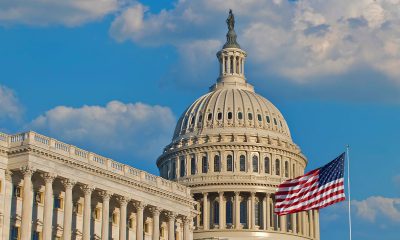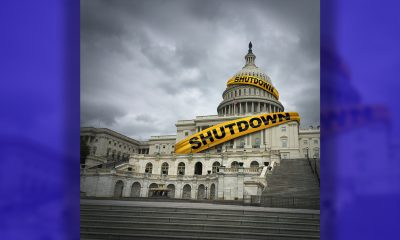Bay Area
The Church Community Responds to COVID-19

“God is our refuge and strength…therefore we will not fear.” Psalm 46: 1-2
Much has been discussed about the coronavirus and how it has impacted grocery outlets, schools, businesses, gyms, salons and recreational facilities. Yet minimal attention has been given to how COVID-19 has affected the church community.
Dr. Cindy Christovale, co-pastor at River of Life Christian Fellowship Church in Oakland, noted that COVID-19 has dramatically changed the way church services are held and how using technology is now the new norm to reach parishioners.
“With social distancing and amid health and safety concerns, congregations have creatively reached out to church members through the internet, social media and sites such as steaming live on Facebook, Periscope, YouTube, and Twitch to conduct services for smaller churches,” said Christovale.
“Additionally ZOOM, the site for meetings and video conferences, has become a very useful tool to effectively reach church-goers that have sheltered in place, especially for older generations.
“Everything we talk about at River of Life is based on the biblical foundation of truth,” she said. “We realize that COVID 19 has affected everyone, spiritually, physically and financially. Knowing the hardships people are facing, we have to reach out to our congregations via phone, text messaging, and social media to let them know the church is there for them.
“The Body of Christ is responsible to come together and pray about our situation,” she added. “We are now suffering because the Body of Christ has been separated since the last presidential election. The enemy has caused division among the Body of Christ.
“As a result of this, we were not prepared for this pandemic and we were lacking our armor. We should continue to read our Bible and pray every day, and not just when we have a present need.”
Rev. Anthony L. Hughes, MDIV, senior pastor at St. Paul AME Church in Berkeley, said parishioners are missing the face-to-face contact, but it’s necessary because of the pandemic. “We no longer have that opportunity to have close contact,” said Hughes. “Reaching out by phone and video streaming is now commonplace.”
“This also applies with giving to the church,” said Hughes. “People have adapted to paying their tithes and offerings electronically. This can be done using the app Givelify on your smart phone by simply identifying your church and the ministry you want to give to.
“Alternatively, if you bank online, parishioners can use Zelle which is a giving program that all banks have. Monies can be transferred to your church by simply entering the church’s email address or phone number, and select the ministry you want to provide funding.”
Hughes stated that during these difficult times, it is important to consider prayer. “One of the main things prayer does is that it keeps us in touch with the spirit of God,” said Hughes. “That’s where we get our direction, our assurance and that’s how we keep our faith strong.”
“Those things come through prayer, so it’s very important that we pray to reach the church community. When this pandemic is over, people will be more appreciative of each other and we will strengthen our ministries with a new enrichment that was not present before.”
Both Christovale and Hughes believe the churches that have ignored orders to shelter-in-place have not used wisdom, and those pastors have been holding services to their peril.
“God has never allowed us to put ourselves in danger,” said Hughes. “What those churches are doing is problematic. They should be prioritizing the health, safety and well-being of their members, especially those congregations that have seniors and people with compromised medical conditions.”
Christovale said that the actions performed by defiant churches are unlawful. “The Bible says to abide by the laws of the land, and those churches are unwise for encouraging activities that put their congregations in danger,” she said.
“Churches in the future will be of a new order,” she added. “Places of worship will need to be cleaned and sanitized, and in many instances, people will still have to remain six feet apart. The technology now in use will most likely continue even more so in the future. It will be a new way of life.”
Alameda County
Seth Curry Makes Impressive Debut with the Golden State Warriors
Seth looked comfortable in his new uniform, seamlessly fitting into the Warriors’ offensive and defensive system. He finished the night with an impressive 14 points, becoming one of the team’s top scorers for the game. Seth’s points came in a variety of ways – floaters, spot-up three-pointers, mid-range jumpers, and a handful of aggressive drives that kept the Oklahoma City Thunder defense on its heels.

By Y’Anad Burrell
Tuesday night was anything but ordinary for fans in San Francisco as Seth Curry made his highly anticipated debut as a new member of the Golden State Warriors. Seth didn’t disappoint, delivering a performance that not only showcased his scoring ability but also demonstrated his added value to the team.
At 35, the 12-year NBA veteran on Monday signed a contract to play with the Warriors for the rest of the season.
Seth looked comfortable in his new uniform, seamlessly fitting into the Warriors’ offensive and defensive system. He finished the night with an impressive 14 points, becoming one of the team’s top scorers for the game. Seth’s points came in a variety of ways – floaters, spot-up three-pointers, mid-range jumpers, and a handful of aggressive drives that kept the Oklahoma City Thunder defense on its heels.
One of the most memorable moments of the evening came before Seth even scored his first points. As he checked into the game, the Chase Center erupted into applause, with fans rising to their feet to give the newest Warrior a standing ovation.
The crowd’s reaction was a testament not only to Seth’s reputation as a sharpshooter but also to the excitement he brings to the Warriors. It was clear that fans quickly embraced Seth as one of their own, eager to see what he could bring to the team’s championship aspirations.
Warriors’ superstar Steph Curry – Seth’s brother – did not play due to an injury. One could only imagine what it would be like if the Curry brothers were on the court together. Magic in the making.
Seth’s debut proved to be a turning point for the Warriors. Not only did he contribute on the scoreboard, but he also brought a sense of confidence and composure to the floor.
While their loss last night, OKC 124 – GSW 112, Seth’s impact was a game-changer and there’s more yet to come. Beyond statistics, it was clear that Seth’s presence elevated the team’s performance, giving the Warriors a new force as they look to make a deep playoff run.
Activism
Oakland Post: Week of November 26 – December 2, 2025
The printed Weekly Edition of the Oakland Post: Week of November 26 – December 2, 2025

To enlarge your view of this issue, use the slider, magnifying glass icon or full page icon in the lower right corner of the browser window.
Activism
Oakland Post: Week of November 19 – 25, 2025
The printed Weekly Edition of the Oakland Post: Week of November 19 – 25, 2025

To enlarge your view of this issue, use the slider, magnifying glass icon or full page icon in the lower right corner of the browser window.
-

 Activism3 weeks ago
Activism3 weeks agoOakland Post: Week of November 12 – 18, 2025
-

 Activism2 weeks ago
Activism2 weeks agoIN MEMORIAM: William ‘Bill’ Patterson, 94
-

 Activism3 weeks ago
Activism3 weeks agoHow Charles R. Drew University Navigated More Than $20 Million in Fed Cuts – Still Prioritizing Students and Community Health
-

 Bay Area3 weeks ago
Bay Area3 weeks agoNo Justice in the Justice System
-

 #NNPA BlackPress3 weeks ago
#NNPA BlackPress3 weeks agoThe Perfumed Hand of Hypocrisy: Trump Hosted Former Terror Suspect While America Condemns a Muslim Mayor
-

 #NNPA BlackPress2 weeks ago
#NNPA BlackPress2 weeks agoTrump’s Death Threat Rhetoric Sends Nation into Crisis
-

 #NNPA BlackPress4 weeks ago
#NNPA BlackPress4 weeks agoProtecting Pedophiles: The GOP’s Warped Crusade Against Its Own Lies
-

 #NNPA BlackPress3 weeks ago
#NNPA BlackPress3 weeks agoIn Major Win for Rep. Al Green, Texas Maps Blocked by Federal Judge




























































1 Comment